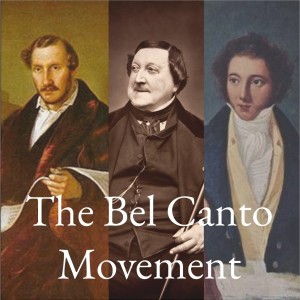
The Bel Canto Movement
1816-1840
Introduction
Bridging the gap between the end of the classical era and the beginning of Romanticism is a movement in opera known as ‘Bel Canto�. This surge of lavishness in composition, attention to detail, and in the sheer number of operas produced, came about as a reaction to the events of the French Revolution. Until this point, opera had primarily been funded and created by wealthy aristocrats, so when their lives and livelihoods were threatened by the events of the Revolution, work in opera had been greatly reduced. For several decades there had been no great leaps forward in style, until the Bel Canto movement took off and found a foothold in Italy and France. This guide will explore the work of Rossini, Donizetti, and Bellini, and analyze the changes in style and composition of popular operas during this period.
Terminology
- Baroque: Relating to or denoting a style of European music, art, and architecture of the seventeenth and eighteenth centuries.
- Bel Canto: Translates as “beautiful singing�; a popular singing style in Italian opera from the mid-eighteenth to early nineteenth centuries.
- Castrati: Male singers who retained their treble voices through a process of early castration.
- Colloratura: Elaborate ornamentation of a vocal melody.
- Falsetto: A method of voice production used by male singers, especially tenors, to sing notes higher than their normal range.
- Fioratura: A written or improvised embellishment of a melody.
- Haute-contre: The highest male voice in French opera.
- Legato: Playing or singing in a smooth flowing manner, without breaks between notes.
- Opera Buffa: A style of comic opera developed in Italy.
- Opera Seria: A style of opera developed in Italy on a serious (usually classical or mythological) theme.
Key Dates & Events
- 1789-1799 French Revolution
- 1792 Gioacchino Rossini was born in Pesaro
- 1797 Gaetano Donizetti was born in Bergamo, Lombardy
- 1800 Manuel Garcia’s New Treatise on the Art of Singing is published
- 1810 Rossini’s first opera Il cambiale di matrimonio is produced
- 1801 Vincenzo Bellini born in Catania, Sicily
- 1813 Rossini’s L’italiana in Algeri
- 1814 Rossini’s Il turco in Italia
- 1816 Rossini's Il barbiere di Siviglia
- 1817 Rossini’s La Cenerentola
- 1817 Rossini’s La gazza ladra
- 1823 Rossini’s Semiramide
- 1824 Rossini appointed at the Theatre-Italien, Paris
- 1825 Rossini’s last Italian opera Il viaggio a Reims premieres for the coronation celebrations for Charles X.
- 1825 Rossini’s Le Comte Ory
- 1825 Bellini’s Adelson e Salvini
- 1826 Rossini’s first French-language opera Le siège de Corinth is produced
- 1829 Rossini’s Guilliame Tell / William Tell premieres, famous for its distinctive overture and for being Rossini’s last opera
- 1830 Bellini’s I Capuleti ed i Montecchi
- 1830 Bellini’s Norma
- 1830 Bellini’s Beatrice di Tenda
- 1830 Donizetti’s Anna Bolena, the first ‘Tudor Queen�
- 1832 Donizetti’s L’elisir d’amore
- 1833 Donizetti’s Lucrezia Borgia
- 1834 Donizetti’s Maria Stuarda, the second ‘Tudor Queen�
- 1835 Bellini’s I puritani
- 1835 Bellini dies
- 1835 Donizetti’s Lucia di Lammermoor
- 1835 Donizetti’s Roberto Devereux, the final ‘Tudor Queen�
- 1840 Donizetti’s La fille du Regiment
- 1848 Donizetti dies
- 1855 Manuel Garcia develops a series of reflective mirrors to see the vocal folds to analyse the mechanism of singing, which went on to influence the development of the laryngoscope
- 1868 Rossini dies
Context & Analysis
To support the return to the social prestige of opera, budgets for performances were greatly expanded, meaning costumes and sets could be much larger and orchestras could increase in size. Rossini took his inspiration from the compositions of Mozart, which as yet were reasonably unknown, and expanded on his theories to produce many works of great beauty.
to read our learning module for The Bel Canto Movement and to unlock other amazing theatre resources!ÐÇ¿ÕÓéÀÖ¹ÙÍø Resources
ÐÇ¿ÕÓéÀÖ¹ÙÍø Sections
Guides
Composers
- Giacchino Rossini
- Jacopo Ferretti
- Eugene Scribe
- Charles-Gaspard Delestre-Poirson
- Giovanni Gherardini
- Cesare Sterbini
- Gaetano Rossi
- Vincenzo Bellini
- Felice Romani
- Carlo Pepoli
- Gaetano Donizetti
- Salvadore Cammarano
- Giuseppi Bardari
Operas
- The Barber of Seville
- La Cenerentola
- Semiramide
- La gazza ladra
- Le Comte Ory
- La Donna del Lago
- Lucia di Lammermoor
- Elisabetta, Regina d’Inghilterra
- Il turco in Italia
- Il viaggio a Reims
- L’italiana in Algeri
- Otello; ossia Il Moro di Venezia
- Norma
- Lucrezia Borgia
- La favorita
- Adelson e Salvini
- I capuleti ed i Montecchi
- Beatrice di Tenda
- Anna Bolena
- Don Pasquale
- Emilia di Liverpool
- La fille du régiment
- L’elisir d’amore
- Maria Stuarda
- Roberto Devereux
- Moise et Pharaon
Songs
- Bel raggio lusinghier
- Cruda sorte
- Languir per una bella
- Assisa un piè di salice (The Willow Song)
- Largo al factotum
- Una voca poco fa
- Nacqui all’affano and Non più mest
- Come un’ape ne� giorni d'aprile
- Ah! Quel giorno ogni rammento
- Bella siccome un angelo
- Per questa fiamma in domita
- Quel guardo il cavaliere
- Udite, udite o Rustici
- Una furtiva lagrima
- Ah! Mes amis
- O mio fernando
- Regnava nel silenzio
- Casta diva
- Sgombra e la sacra selva
- O quante volte
- Se Romeo t’uccise un figlio
- Il segreto per esser felici
Blog Posts
Links & Media
Quizzes

Wendy Silvester
Singer and vocal coach based in the UK.